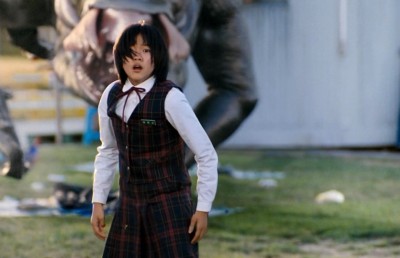Film on the Internet
Cinema on the Electronic Highway

This is not a theater. Here, the viewer is in control.
“Dogma 2001: The New Rules for Internet Cinema”

The evolution of film exhibition has, in a sense, come full circle. The first public screenings of moving pictures were in 1893 with Edison’s Kinetoscope’s, where a single person would put a coin into a stand-up wooden cabinet to view a 30 second film in a peephole viewfinder. Films then moved to a variety of ‘public’ locations (vaudeville theatres, amusement parks, carnivals, etc.) where the film was just one of several entertainment acts on a program, then to the first dedicated (mainly storefront) cinema houses during the Nickelodeon era (1905-1913), before the period of the movie palaces in the 1920s, which would proof the mainstay of the industry for decades. Since then movie exhibition has spread to include the popular drive-in theatres, televison, multiplex theatres, and museums, before returning ‘full circle’ to the single viewing experience of the home computer and the world wide web. Although the televison can be viewed by a single person, the original marketing for the new television promoted it as a ‘family’ experience; which is not the case with the home computer, which is normally set-up for the single principle viewer, much like its distant technological cousin, the Kinetoscope. In fact one of the pioneers of internet (or web) cinema, Lev Manovich, was the first to note this parallel, when he wrote, “the introduction of QuickTime in 1991 can be compared to the introduction of the Kinetescope in 1892: both were used to present short loops, both featured the images approximately two by three inches in size, both called for private viewing rather than collective exhibition” (“About ‘Little Movies’”).
Just as cinema had its own progenitors (Kinetescope, chronophotograph, the magic lantern, praxinoscope, etc.), web cinema had its antecedents with the appearance of Quick Time software and CD-ROM in the early 1990s. While the first generation of web cinema was under the influence of television, evident in the content of these first web films (soap operas and one-minute film serials), by 1999 web cinema already had its first annual film festival in a Paris café (The International Festival for Films on the Internet, FIFI). By 2000 web cinema had already matured, with web cineastes looking for ways to experiment with the form and medium of web cinema; and many dedicated web cinema sites began sprouting all over the internet. While web cinema started primarily in North America, European web cineastes joined the web cinema community in early 2000 and, because of good support by the broader film community (film festivals such as Rotterdam, museums such as the Georges Pompidou, government grant agencies, associations), quickly made important contributions to web cinema.
Film on the internet can be broken down into three broad categories: 1) Web sites that function as archives for mainly non-commercially viable films 2) Web sites that function as distributor/exhibitor of movies made exclusively for the internet (which I will call ‘internet cinema’), and 3) Web sites that function as promotional material for theatrical film releases (official film sites, trailers, electronic press kits).
In this article I will concern myself with the first two categories. One form of cinema that has been helped by the internet archiving of the first category are ephemeral films, which are (mainly) non-fiction films that were never intended to be viewed after the period they were made. Ephemeral film is a broad beast encompassing government, industrial, advertising, and educational films. Since style and technique was never a major concern for ephemeral cinema, they seem a good fit to the haphazard nature of web viewing (with image quality partly conditioned by factors beyond the filmmaker’s control, such as connection speed, monitor, and video card). The website The National Archives houses mainly ephemeral films but includes ‘home videos,’ and classic silent films (like Georges Melies’ The Black Imp, and student films). Archival cinema websites are like a repository for orphan forms and films which would otherwise have no shelf life after their creation, like ‘reality tv’ inspired films, home movies, bloopers, ‘funniest home videos,’ sports highlights, music videos, and, of course, ephemeral films. Even here there are some nuggets, like the Orson Welles-narrated documentary on extraterrestial life, “Who Goes There?” Of more historical and entertainment value is the Moving Image Archive website, curated by Skip Elsheimer, which claims to have in its database 10% of all ephemeral films made between 1927 and 1987. The Moving Image Archive contains over 20,000 rare and ethnographically fascinating films in its image bank of over two dozen collections. The highlight is the Prelinger Archive, named after the film archivist who coined the term ephemeral films, Rick Prelinger. This collection houses over 2000 films, including commercials, news items, animated films, and social guidance documentaries which have become fascinating snippets of cultural history. Over 100 amateur francophone films are gathered in the “Kino French Films” collection; while the single largest collection with over 19,000 titles is “Open Source Movies,” which is a collection of mainly amateur films posted by the vast online community. Of more interest to the cinephile may be the “Feature Film” collection, a variety of public domain feature films which can be viewed streamed or downloaded to view on your computer or burn onto dvd.
In terms of cost to the user, there are two basic types of internet cinema websites, the commercial ones, where you pay a download fee or membership to access the more high profile films, and those that are free. Some of the commercial sites offer some free material but at the price of heavy advertising. Examples of the commercial internet cinema website include ICinema, Bijou Café, and Internettv. The majority of the films on these sites are DIY’s (do it yourself) amateur and semi-amateur films. Two of the oldest and most visited free movie internet sites are IFilm and Atom Films. As the norm, most of the free material is reconstituted funny commercials, bloopers, television oddities, trailers, amateur films, or “viral videos,” which is a category of promotional and marketing videos on Ifilm that have surprising shelf value (like David Lynch’s 1991 New York anti-litter promo). With websites such as Ifilm and Atom Films, internet cinema co-exists alongside existing material not exclusively made for the internet. Although in an interesting new initiative, Atom Films has begun featuring short films which it has self-produced and funded under the banner ‘AtomFilms Studio’. Included as part of this initiative is a funny and entertaining ongoing short horror/science-fiction/dark comedy series call “HellHoles.” A free membership with Atom Films allows you to view the films in hi-def full screen.
Eclipsing all of the websites in the first category terms of pure content number is the recent YouTube phenomena. It is only a slight exaggeration to say that you can see just about everything on Youtube, from rare musical performances, sporting highlights, commercials, comedy acts, etc. If you don’t believe, just do a search on Jimi Hendrix and peruse the links (if you have a few spare hours).
The more interesting and potenitally groundbreaking ventures are the web sites that are dedicated exclusively to internet cinema. One of the first of such websites is New Venue (since 1996), which includes a section (“Flick Tips”) on how to make digital movies. Another popular website exclusively geared toward made-for-internet film and with a mandate to educate is Plugincinema. Plugincinema actively promotes internet cinema as a particular breed of cinema apart from theatrical and television cinema. It also tends more toward the experimental form, which is a welcome divergence from the majority of web-made cinema sites which feature more popular forms such as animation, narrative, and documentary. Plugincinema is a good place to start for newbies to the world of internet cinema because it has a pluginmanifesto which lays out the philosophy of their understanding of internet cinema.
Based on a healthy sampling of films across several of these internet websites, the following generalities can be made: the large majority of internet cinema is short length (2-20 minutes), with narrative and non-narrative (experimental, documentary, home video, commercials) equally represented across the world wide web; stylistically, the close-up dominates (long shots are rare), when it comes to sound, silent, music only, voice-over or wild sound dominates over sync sound; as a compromise between size and universal download time, the screen size is normally either 320×240 or 640×480; and the majority of internet movies are either filmed with a digital camera and/or with a computer animation software tool such as Micromedia Flash (though Super 8mm and 16mm are also used and digitized). The process for viewing internet films online is similar across all these websites, and is as easy as clicking on the related hyperlink, which will then launch the movie file in one of (usually) three plug-ins: Realplayer, Windows Media, Flash, or Quicktime. The internet film is either viewed streaming or downloaded onto the user’s computer. Though there is some difference from site to site, the image/sound quality of internet films is dependent on both the filmmaker (quality of the camera, compression rate) and the viewer’s computer setup (monitor, speakers, connection speed, video card, etc.). The short film format is so dominant in the world of internet cinema that there are several web sites that market themselves exclusively toward the short film, such as Cine-Courts, which specializes in French shorts under 12 minutes in length.
In her important essay “Telling Stories on Screen: A History of Web Cinema,” Nora Barry positions web cinema as a intermediary between conventional fixed screening locations (theatres, television, home computers) and mobile screen locations (buses, retail outlets, subways, mobile phones). While conventional cinema can not be adapted for these transitory viewing forms because of its length and reliance on plot, internet cinema has the potential to do so, which opens up a vast potential market in the near future. Barry notes that because internet films are normally made by one person (auteurist) without the need for publicists and producers, the stories are usually more personal and idysioncratic (Barry, 544-545). This creates a direct one-to-one link between the producer and consumer, and relates to one of the most defining qualities of internet cinema: its interactive potential, which ranges from linear flow (when to start/stop the movie) to more complex narrative permutations (order, sequence).
The notion of interactivity is also evident at the production stage, in what Barry calls “pass-along-narratives,” which are films made by one person and posted on the web which are then added to by filmmakers from around the world to form a truly global, collectively directed film. Examples include Planet Invasion (Marco and Antonio Manetti, 2000) and Julie 9 (Julie Myers, 2001) (Barry, 546-547).
However, the notion of interactivity more commonly understood involves a relationship between product and consumer. There are properly speaking two levels of interactivity, although the first level does not stretch out much further than earlier mediums. The first level of interactivity is the rule of the mouse click —where the viewer can play with the flow of the narrative, as when reading a novel, or pausing/skipping on a digital video. Second level interactivity, which is what separates internet cinema from the conventional theatre experience, involves a symbiosis between the viewer and the technoloigcal condition of the viewing experience. Here the viewer is able to actively give shape to the narrative in one of several ways: by either choosing from a choice of set parameters or programmed set of narrative options (like characters, settings, images, music, sound, etc.); or by selecting a particular ‘path’ for the parameters, from which the film is programmed to randomly ‘shuffle’ between, much like a music CD; or by changing between different windows or sections of the screen.
This form of ‘controlled randomness’ is part of what Marsha Kinder calls ‘database cinema.’ In 1997 Marsha Kinder became involved in the “Labyrinth Project,” a research study into the “dialogue between the language of cinema and the interactive potential and database structures of new media” (p. 346). One of the pioneers of database cinema is Lev Manovich, author of The Language of New Media, creator of the first web cinema project created between 1994-1997, “Little Movies: Prolegomena for Digital Cinema” and the database cinema project “Soft Cinema.” According to Manovich his project demonstrates “the possibilities of soft(ware) cinema – a ‘cinema’ in which human subjectivity and the variable choices made by custom software combine to create films that can run infinitely without ever exactly repeating the same image sequences, screen layouts and narratives” (Soft Cinema). Theoretically, Manovich sees database structures and narrative as “two competing imaginations, two basic creative impulses, two essential responses to the world” (quoted by Marsha Kinder, p. 348). Contrary to Manovich, Kinder sees the two forms as being creatively compatible because they expose the “dual processes of selection and combination that lie at the heart of all stories and are crucial to language” (p. 349).
In either case, it is clear to me that internet cinema, barely eleven years old, has yet to find its own niche in terms of aesthetics, style, form, and purpose. Whether internet cinema evolves into something lasting, or a strong voice for alternative cinema, or even remains as a viable exhibition site for cinema, or whether it becomes just another one of the multitude of ‘screens’ that have risen since the beginning of cinema is largely connected to the broader question of interactivity: Do we really want interactivity in our narratives? Do we really want (or need) what Manovich calls ‘ambient narrative’? Images and moving images are a product humanity’s unsatiable desire for storytelling, in whatever form (neat and classical, fragmented and modern, messy and postmodern). Part of the appeal of storytelling is the pleasure of being led somewhere, of being tricked, fooled, and surprised. As consumers of storytelling the viewer (or reader) desires a loss of control to the whims and fancy of the creator-artist. Once we begin selecting the flow of the story, who dies and who lives, how the story ends, or how it begins, we have arguably become second-level ‘co-creators,’ and the masochistic pleasure of surrendering control is lost.
Concurrently, such a process can only exist at a single-viewer level. A theatre full of viewers can not preordain the narrative in 100 directions at the same time. Hence the interactivity element of web cinema can never become a social process, which robs it of, arguably, cinema’s most important function. But the nature of web cinema’s singular viewing experience offers its own unique, small pleasures: spontaneous, ever-present, cheap (if you own a computer), and diverse. The more imaginative web cineastes attempt to make up for the small size of the viewing screen (compared to the theatre) by ‘enlargening’ other possibilities of visual/auditory experience, including interactivity, the mapping of different programming options, the endless possibilities of image/sound conjunctions, shifting between 3-D depth and 2-D flatness, between multiple window panes, and immersing the viewer into the virtual world of the fictional mind-space. The only thing that is certain is that the nature of the beast will change, and the parameters for internet cinema will mutate and evolve, especially when, as often predicted though still far from a reality, all of cinema goes completely digital.
Although one can detect certains patterns where aesthetics, style, and form are concerned, it is difficult to identify a niche or sense of purpose for internet cinema (Entertainment? Fame? Fortune? Communication? Art? Advertisement? Industry?). Although barely eleven years old, time in the world of computer and digital technology moves at a far greater acceleration than normal human time. With internet cinema tied to computer and digital technology perhaps it can never be in any one ‘place’ long enough to establish a singular identity or sense of purpose. For example, above I mentioned the ‘small screens’ of the webcinema viewing experience, but with computer screens inching bigger and bigger to the point where 22 and 24 inch widescreen monitors are becoming the norm, ‘small’ is indeed only relative. In philosophical terms, perhaps the nature of internet cinema is to be fluid and amorphous, always Becoming and never Being.
PS: I have decided not to point the reader to too many specific film titles at the noted websites, since self-discovery is one of the pleasures of internet cinema.

The photo above is the front cover of a wonderful book entitled Future Cinema: The Cinematic Imaginary after Film ed. By Jeffrey Shaw and Peter Weibel. It is a monster book of over 600 glossy pages with beautiful illustrations of hard to see films, video art, film-installations, and museum films. It is one of the best books I’ve ever read on the interaction of cinema and new technologies (web-based cinema/installations, video art, computer-based installations, DVD-ROM interactive arts). There is a website to the book.
Bibliography
“Dogma 2001: The New Rules for Internet Cinema.” Accessed July 15, 2006.
Manovich, Lev. “About ‘Little Movies.’” Accessed July 3, 2006. [Original link is dead. New link added on January 1, 2022: https://variants.artbase.rhizome.org/Q4333/statement-new3.html
Manovich, Lev. “An Archeology of a Computer Screen.” Kunstforum International. Germany,1995; NewMediaTopia. Moscow, Soros Center for the Contemporary Art, 1995. Accessed July 5, 2006.
Manovich, Lev. Soft Cinema.
Marsha Kinder. “Designing a Database Cinema,” pps. 346-353. Future Cinema: The Cinematic Imaginary after Film. Ed. Jeffrey Shaw and Peter Weibel, ZKM/Center for Art and Media Karlsruche, The MIT Press, Cambridge, Massachusetts, 2003.
Nora Barry. “Telling Stories on Screen: A History of Web Cinema,” pps. 544-551. Future Cinema: The Cinematic Imaginary after Film. Ed. Jeffrey Shaw and Peter Weibel, ZKM/Center for Art and Media Karlsruche, The MIT Press, Cambridge, Massachusetts, 2003. Also available online. Accessed January 15, 2006.
Referenced Web Sites
A much abbreviated version of this essay first appeared in a French translation as “Internet drague le cinéma: les plaisirs visuels de l’autoroute électronique,” in 24 Images No. 129, October-November 2006, 22-23.














